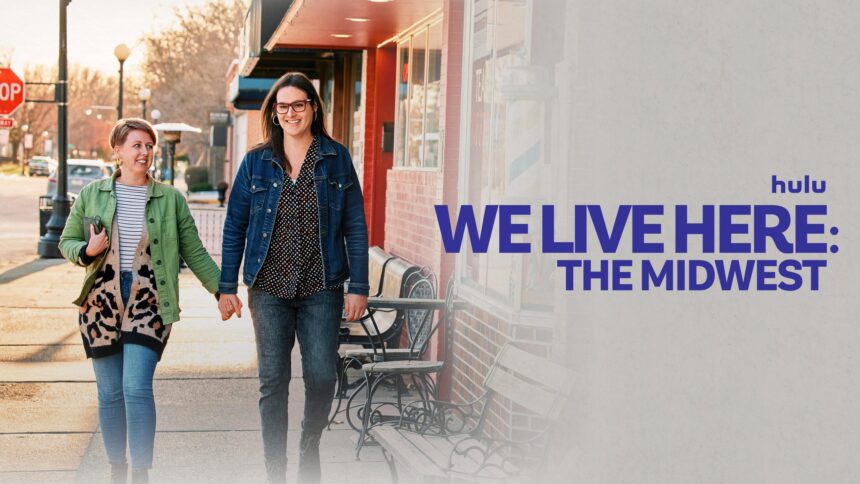(We Live Here: The Midwest promotional poster. Image source: Hulu)
“I desperately miss the church,” Des Moines resident Katie Chiaramonte shares, tearing up. Forcing a laugh, she continues, “There’s like a lot of emotion attached to it. I gave a significant amount of my life to the church because I love the people so much.”
Katie’s wife Nia came out as a trans woman and transitioned after they married and had children. But Katie says people rarely ask her about religion as a queer woman in the Midwest. In Hulu’s 2023 documentary We Live Here: The Midwest, Katie and four other families not only challenge the myth that LGBTQ people do not live in the region, but also that they aren’t religious. LGBTQ Midwesterners have existed and continue to exist and thrive in Midwestern states and in religious communities, despite sometimes facing violence and religious prejudice.
We Are Here: The Midwest is not the first work to document and celebrate queer Midwestern experiences. In the 2019 book Real Queer America: LGBTQ Stories from Red States, trans reporter Samantha Allen shares her love for the “flyover” states and the LGBTQ people who choose to stay and pioneer queer communities in conservative religious and political spaces. Similarly, in 2021’s Sweeter Voices Still: An LGBTQ Anthology from Middle America, Ryan Schuessler and Kevin Whiteneir, Jr. weave together stories of queer religious struggle and joy.
The 52-minute documentary We Live Here: The Midwest, directed by Melinda Maerker and produced by David Clayton Miller, takes a similar approach and features five queer partners and families. The first, Nia and Katie Chiaramonte, a trans woman and queer woman living with their five children in Iowa, struggle to find a community after facing bigotry at their church.
In contrast, Mario and Monte Foreman-Powell, Black gay men living with their baby daughter in Nebraska, were surprised to find a support network among their neighbors. However, despite meeting each other in a Colorado church where Mario was the music director and Monte a singer, Mario lost his job when his pastor forced him to come out. This was the second time Monte was pushed out of a church position because of his sexuality.
Farming lesbian couple Denise and Courtney Skeeba from Kansas tell viewers there is something inherently queer about the Midwest, specifically how many Midwestern women, according to the stereotype, dress and present as butch. They also share how their son was bullied so intensely that they took him out of public school.
Bullying was also a theme for Russell Exlos-Raber, a married gay man in Ohio, who shared his own experiences with bullying and with the bullying he has witnessed at the school where he teaches. In response, Exlos-Raber has hosted discussion groups a prom for LGBTQ students at his school.
Finally, Debb and Jenn Richmond, a trans couple in Minnesota, recount the transphobia they encountered within their own families. Jenn’s sons threatened to murder her. Debb’s daughters struggled with how her transition unsettled the family, later accepting her back into the family even though they still call her “dad.”
Through each of these stories, the documentary highlights how finding and sustaining community is a big part of why LGBTQ people either stay or leave the Midwest. In many Midwestern places, community is closely tied to local churches, synagogues, and mosques, so being cast out of these communities, as three families in the documentary describe, is a crippling loss. At the same time, LGBTQ Midwesterners are forming their own communities or fighting for reform and visibility inside communities who continue to hurt them.
Taking Up Space as a Queer Midwesterner
As a queer woman who grew up in a Chicago suburb and graduated from Ball State University in Muncie, Indiana, I have spent several years reflecting on what it means to be a queer Midwesterner, and even more a religious queer Midwesterner. I came out to myself early in college, but I waited to come out to family and friends after I moved to Washington, DC for safety reasons. In the wake of the 2016 election, Trump supporters drove across my campus, one of the most liberal areas in the region and one with a visible queer presence, and threw eggs and bottles at students.
For much of my life, I bought into the stereotype that these identities—queer, Midwestern, and religious—were incongruous. But as an undergraduate, coming face to face with people challenging this assumption helped me to dismantle this stereotype.
I participated in a research study where I documented the stories of other queer people in Muncie and the wider Midwest. I documented these histories in the 2021 Muncie-based exhibition Midwestern Stories. I also conducted oral history interviews with religious LGBTQ folx, religious allies, and queer people who distanced themselves from religion as part of the Muncie LGBTQ+ History Project. The interviews affirmed my understanding of the Midwest as a place largely dominated by traditional gender values that can restrict the rights and survival of queer families.
But at the same time, these conversations challenged my perspective of the Midwest and showed me how queer people can thrive in Middle America. And because of the importance of religion in community making, I quickly discovered how queer religious communities can also flourish in the heartland.
Leading and Creating Affirming Religious Spaces
The documentary opens with Katie and Nia discussing living in Iowa and how closely Christianity is integrated into Midwestern culture. The pair were childhood best friends, both intimately involved in their churches. When they first began to date, in line with their churches’ teachings, they dated to marry. The pair eventually tied the knot and had five children before Nia came out as trans. Both before and after Nia’s transition, Katie regularly preached at their non-denominational evangelical church as a layperson.
“When I came out,” Nia explained, “all the energy got focused onto Katie and her preaching. Nobody would outright say something that was transphobic, but it was, ‘Katie your theology is bad.’” Instead of saying they were bothered by a trans person in the church or a queer couple with a prominent position within their community, members of her church argued that Katie’s approach to Christianity was faulty, and that she was less of a Christian. But the only thing about her or her preaching that had changed was her support of Nia.
Continuing her relationship with Nia is what made her a “bad” Christian to her fellow churchgoers, Katie explains. But she disagrees, arguing instead that Jesus held unconditional love for and reached out to marginalized communities. “And it utterly breaks my heart that my unconditional love for Nia,” Katie shared, “was the thing that had to break my relationship with the church because, for me, it is the church. Like, for me, this is my religion. This is my faith. This kind of love.”
Nia says she found spiritual community elsewhere. “I have found community in other places, that is the thing that the church really gave me, and the thing that I loved about church was the relationship, and I think God is relationship, and so, to me, you know, finding that in other places is finding God elsewhere.”
Katie and Nia’s story highlights how, despite religious prejudice, religion remains an important part of some queer people’s lives. Some even find and establish religious communities of their own. Katie specifically speaks to this point in the documentary, showcasing how LGBTQ individuals have created queer religious communities like the aChurch4Me Metropolitan Community Church in Chicago, Circle Sanctuary in Wisconsin, Soulforce in Minnesota, and The Church Within in Indianapolis.
Rebelling by Staying in the Midwest
Today, many parts of the Midwest are increasingly rightwing and Christian nationalist. Republican politicians are pushing for anti-LGBTQ legislation and denying queer Midwesterners the rights to bathrooms, sports, drivers licenses, and gender affirming care in line with their gender identity. Today, there are 489 anti-LGBTQ bills on the docket, the majority concentrated in Midwestern states.
Everyone in the documentary has the choice: do you stay and commit to building your community at a time when LGBTQ people are losing legal rights at an alarming rate, or do you leave?
In Nia’s opinion, leaving would mean the anti-LGBTQ lawmakers and their supporters won. The conservative bigots would have effectively cast out another trans and queer person from the Midwest. Staying in the Midwest means that anti-LGBTQ politicians and their supporters have failed.
This sentiment is also shared by LGBTQ people who remain in explicitly or implicitly homophobic communities. Some stay because they have no other community. Others, however, fight for their rights and recognition in homophobic religious communities and hold their ground.
Queer Midwesterners, like the five families in the documentary, affirm that despite growing conservatism, LGBTQ people come from and exist in the heartland and that they are there to stay. Even more, they join a decades-long tradition of queer people and queer religious Midwesterners carving out their own safe queer spaces.
As I watched this documentary, I realized why it was important for me to proclaim my identities as queer, religious, and Midwestern. Just like everyone featured in We Live Here, my existence and visibility have the potential to make the Midwest safer and more inclusive.
Queer, religious Midwesterners exist and they are not going away.
Emma Cieslik is a freelance writer and museum worker based in the Washington, DC area.





